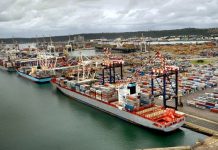
The Ports of Los Angeles and Long Beach have decided to further postpone the “container dwell fee” until 29 November, given the continued progress of moving containers off marine terminals.
Since the fee, directed to ocean carriers for import containers that dwell on marine terminals, was announced on 25 October, the twin US ports have seen a decline of 33% combined in ageing cargo on the docks, according to a statement.
The two West Coast ports had firstly announced the container dwell fee postponement until 22 November, but given the efficiency of this measure, they finally decided to extend its effect in order to further diminish congestion at the marine terminals.
This policy was developed in coordination with the Biden-Harris Supply Chain Disruptions Task Force, US Department of Transportation and multiple supply chain stakeholders.
The executive directors of both Californian ports expressed their satisfaction with the progress so far and they declared that they will reassess fee implementation after another week of monitoring data.
“Any fees collected from dwelling cargo will be reinvested for programs designed to enhance efficiency, accelerate cargo velocity and address congestion impacts,” reminded the ports.
The temporary policy approved on 29 October by the Harbor Commissions of the San Pedro Bay ports determines that ocean carriers can be charged for each import container that falls into one of two following categories.
In the case of containers scheduled to move by truck, ocean carriers could be charged for every container dwelling for nine days or more, while, for boxes transferred by rail, ocean carriers could be charged if a container has dwelled for six days or more.
The two busiest ports of the United States plan to charge ocean carriers in these two categories US$100 per container, increasing in US$100 increments per container per day until the container leaves the terminal.
Before the pandemic-induced import surge began in the middle of 2020, containers for local delivery remained on container terminals under four days on average, while containers destined for trains dwelled less than two days.





